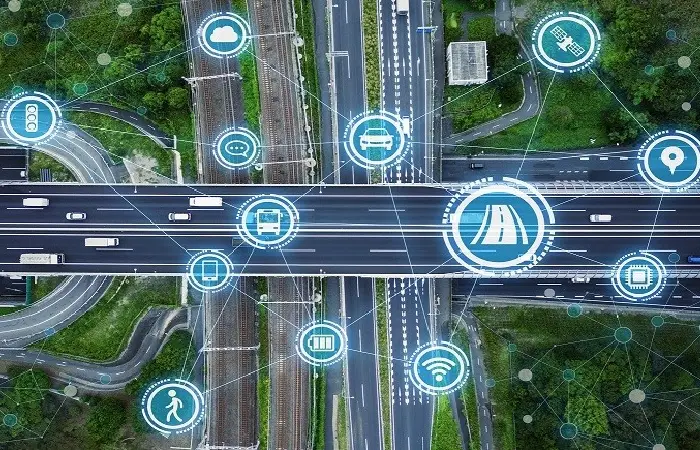Transportation Infrastructure – Artificial intelligence (AI) redefines how we interact with the digital universe. Whether at work or home, AI has infiltrated most of our online activities.
But this is only the beginning. Some genuinely revolutionary advances are yet to come in our relationship with the physical world, and nowhere is this likely to be more prevalent than in how we travel.
Much of this will come from intelligent data collection and analysis automation to streamline traffic and improve security.
But AI is also poised to reinvent transportation infrastructure, making it more durable and less expensive to build and maintain.
Smarter ways to travel

Roads
Let’s take a simple road as an example. From the dirt roads of primitive times to the modern engineering constructions of today, roads essentially serve as the surface that allows reasonably smooth travel for wheeled transportation.
In the modern world, roads have taken on a new role as digital conduits. They now facilitate efficient transportation from one place to another. These digital roads allow us to optimize routes, helping us reach our destinations most efficiently.
According to Andrey Koptelov, innovation analyst at custom software development company Itransition, smart roads will not only guide our vehicles to their proper destinations but also enforce traffic laws and enable emergency services. They will reduce traffic jams and even prevent accidents.
Once equipped with many sensors, cameras, and other devices – even on the pavement – intelligent management systems will have a wealth of data to ensure that roads operate in optimal conditions regarding climate, volume, and many other factors.
Much of the signage necessary to navigate complex routes could become obsolete. Red traffic lights, for example, can give way to intelligent guidance systems that direct vehicles through intersections quickly and safely.
Optimal routes can be mapped and updated in real-time, allowing you to reach your destination sooner, reduce road and vehicle wear and tear, reduce carbon emissions, or extend battery life.
Intelligent roads are also seen as the answer to the growing diversity of transportation options, especially in dense urban areas.
With the ability to track movement in all its forms, AI will help ensure that pedestrians, cyclists, and users of battery-powered vehicles such as hoverboards can share the roads safely with heavier vehicles and, in many cases, without drastic changes to the streets.
Air Transport
Air transportation is also ripe for an AI makeover. Few people today would question improving the flying experience in the air and at the airport.
Modern airlines and airport authorities face a perfect storm of increased demand and decreased workforce, with the added burdens of security and weather-related disruptions.
AviationFile recently noted that the entire industry focuses on AI to solve these problems.
Predictive maintenance, for example, is greatly improved with intelligent systems based on sensor data. This prevents severe problems for the plane, runway, tower, and critical systems such as boarding and baggage handling.
Helping hands
Security can be managed much less intrusively through facial recognition and behavioral analysis.
At the same time, self-help kiosks and mobile services equipped with intelligent chatbots and virtual assistants allow travelers to make or change reservations, navigate airports, and access many other services, reducing demand on already overstretched airport staff.
Railways
Another crucial piece of transportation infrastructure is rail. Recent events show that a robust rail industry is vital to the economy and public safety.
Global Railway Review recently highlighted how AI could make railways safer and more efficient. As AI has a proven ability to detect problems before they cause accidents, some of them are:
- Automated driving and braking
- State-based supervision
- Collision protection
- Predictive Maintenance
Using tools such as the Nvidia Jetson platform, railway operators are deploying AI at all levels of infrastructure – from the engine and the cars themselves to the tracks, switches, and stations – to gain a complete view of the physical conditions and operations in real-time.
Even when vehicles lose direct connections to the cloud or central servers, intelligent onboard systems can infer from context to make decisions independently.
AI is also helping design and construct new infrastructure to make roads, bridges, and other constructions safer and more durable.
A recent collaboration between AutoDesk and design company Dar produced a 5-meter bridge 3D printed from recycled materials and integrated with sensors into the deck and support structures.
The design opens up the possibility of building even larger structures in situ and integrating them into existing infrastructure in a robotic manner, reducing costs and disrupting traffic flows while improving safety.
The final result
Even as the world becomes increasingly digitalized and we embrace the ability to view the world virtually from the safety of our couches, goods, and people will still need to move physically from one place to another.
As the population grows, finding new and better ways to deploy and maintain transportation infrastructure becomes imperative to avoid the increasing complexity and costliness associated with this task.
AI brings essentially the same capabilities to this task as it does to finance, healthcare, and IT, taking over all the repetitive and routine responsibilities so that humans can focus on the job’s more creative and rewarding elements.
In the process, it eliminates other critical limiting factors such as cost and complexity, allowing infrastructure to advance to meet the needs of a 21st-century economy.
And with more efficient transportation at our disposal, the benefits of human productivity should be more accessible to distribute worldwide.





